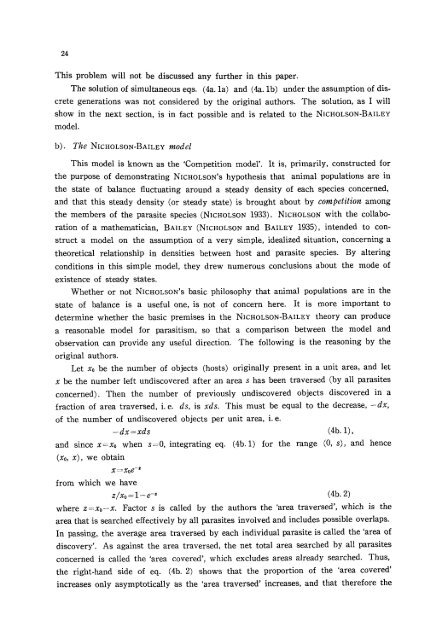A comparative study of models for predation and parasitism
A comparative study of models for predation and parasitism
A comparative study of models for predation and parasitism
You also want an ePaper? Increase the reach of your titles
YUMPU automatically turns print PDFs into web optimized ePapers that Google loves.
24<br />
This problem will not be discussed any further in this paper.<br />
The solution <strong>of</strong> simultaneous eqs. (4a. la) <strong>and</strong> (4a. lb) under the assumption <strong>of</strong> discrete<br />
generations was not considered by the original authors. The solution, as I will<br />
show in the next section, is in fact possible <strong>and</strong> is related to the NICHOLSON-BAILEY<br />
model.<br />
b).<br />
The NICHOLSON-BAILEY model<br />
This model is known as the 'Competition model'. It is, primarily, constructed <strong>for</strong><br />
the purpose <strong>of</strong> demonstrating NICHOLSON'S hypothesis that animal populations are in<br />
the state <strong>of</strong> balance fluctuating around a steady density <strong>of</strong> each species concerned,<br />
<strong>and</strong> that this steady density (or steady state) is brought about by competition among<br />
the members <strong>of</strong> the parasite species (NICHOLSON 1933). NICHOLSON with the collabo-<br />
ration <strong>of</strong> a mathematician, BAILEY (NICHOLSON <strong>and</strong> BAILEY 1935), intended to con-<br />
struct a model on the assumption <strong>of</strong> a very simple, idealized situation, concerning a<br />
theoretical relationship in densities between host <strong>and</strong> parasite species. By altering<br />
conditions in this simple model, they drew numerous conclusions about the mode <strong>of</strong><br />
existence <strong>of</strong> steady states.<br />
Whether or not NICHOLSON'S basic philosophy that animal populations are in the<br />
state <strong>of</strong> balance is a useful one, is not <strong>of</strong> concern here.<br />
It is more important to<br />
determine whether the basic premises in the NICHOLSON-BAILEY theory can produce<br />
a reasonable model <strong>for</strong> <strong>parasitism</strong>, so that a comparison between the model <strong>and</strong><br />
observation can provide any useful direction.<br />
original authors.<br />
The following is the reasoning by the<br />
Let x0 be the number <strong>of</strong> objects (hosts) originally present in a unit area, <strong>and</strong> let<br />
x be the number left undiscovered after an area s has been traversed (by all parasites<br />
concerned). Then the number <strong>of</strong> previously undiscovered objects discovered in a<br />
fraction <strong>of</strong> area traversed, i.e. ds, is xds. This must be equal to the decrease, -dx,<br />
<strong>of</strong> the number <strong>of</strong> undiscovered objects per unit area, i.e.<br />
-dx--xds (4b. 1),<br />
<strong>and</strong> since x=xo when s=0, integrating eq. (4b. 1) <strong>for</strong> the range (0, s), <strong>and</strong> hence<br />
(x0, x), we obtain<br />
X ~Xoe-*<br />
from which we have<br />
z/xo: 1- e-' (4b. 2)<br />
where z=xo-x. Factor s is called by the authors the 'area traversed', which is the<br />
area that is searched effectively by all parasites involved <strong>and</strong> includes possible overlaps.<br />
In passing, the average area traversed by each individual parasite is called the 'area <strong>of</strong><br />
discovery'. As against the area traversed, the net total area searched by all parasites<br />
concerned is called the 'area covered', which excludes areas already searched. Thus,<br />
the right-h<strong>and</strong> side <strong>of</strong> eq.<br />
(4b. 2) shows that the proportion <strong>of</strong> the 'area covered'<br />
increases only asymptotically as the 'area traversed' increases, <strong>and</strong> that there<strong>for</strong>e the















